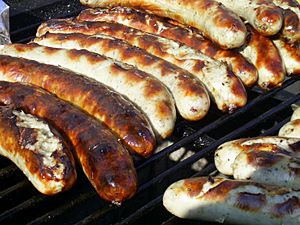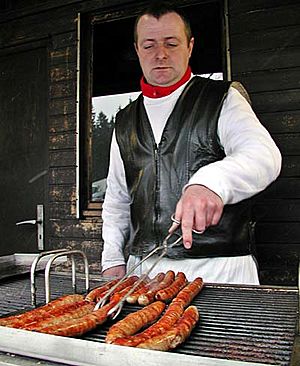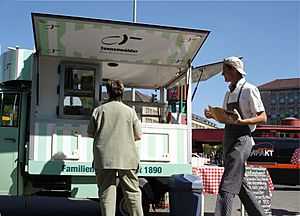Thuringian sausage facts for kids
 |
|
| Alternative names | Thüringer Rostbratwurst |
|---|---|
| Course | Sausage |
| Place of origin | Thuringia, Germany |
| Main ingredients | minced meat, salt and pepper, caraway, marjoram, and garlic |
Thuringian sausage, also called Thüringer Bratwurst in German, is a special sausage. It comes from the German state of Thuringia. This sausage has a special status from the European Union. This means only sausages made in Thuringia, following certain rules, can be called Thuringian sausage. This protects its unique quality and origin.
Contents
History of Thuringian Sausage
Thuringian sausage has been made for many hundreds of years. The very first mention of this sausage was in the year 1404. This was found in a bill from a convent in Arnstadt. The oldest known recipe for the sausage is from 1613. This old recipe is kept in the State Archive in Weimar. Another recipe from 1797 also talks about a smoked version.
How Thuringian Sausage is Made
Only finely ground meat is used to make this sausage. This meat usually comes from pork, beef, or sometimes veal. Most of the meat is taken from the shoulder area. Besides salt and pepper, special spices are added. These include caraway, marjoram, and garlic. The exact mix of spices can change based on old recipes or local tastes.
At least 51% of the ingredients must come from the state of Thuringia. These ingredients are mixed together. Then, they are put into a pig or sheep intestine. Thuringian sausages are different from other German sausages. They have special spices, especially marjoram. They also have less fat, about 25%. Other sausages can have up to 60% fat.
How to Cook Thuringian Sausage
The best way to cook Thuringian sausage is over charcoal. You can also use a grill. Sometimes, the grill is rubbed with bacon first. The fire should not be too hot, so the sausage skin does not break. However, a little bit of charring is good. Sometimes, beer is sprinkled on the sausages while they are grilling.
Usually, a Thuringian sausage is served in a cut-open roll. It is often eaten with mustard.
Thuringian Sausage in Culture
For the people of Thuringia, grilled Thuringian sausage is more than just food. Grilling is a very important part of their culture. Often, beer is used to cool the grill instead of water. The type of grill used is also very important to them.
Mustard is the traditional sauce for the sausage. People often prefer local mustard. A popular one is "Born mustard" from a company in Erfurt. In some parts of Thuringia, it is considered wrong to use any other sauce, even mustard. In eastern Thuringia, "Bautz’ner" mustard is commonly used.
In 2006, the Deutsches Bratwurstmuseum opened. This is the first museum just for the Thuringian sausage. It is located in Holzhausen, near Arnstadt.
A kosher version of the sausage was made in 2016. It used veal and chicken in goat intestines. This was introduced at the annual Onion Festival in Weimar.
Thuringian Sausage in Luxembourg
Before Thuringian sausages got their special PGI status in the EU, a sausage in Luxembourg was called "Thüringer". Now, it is called "Lëtzebuerger Grillwurscht". This means "grill sausage" in Luxembourgish.
de:Bratwurst#Thüringer Rostbratwurst
See also
 In Spanish: Thüringer Rostbratwurst para niños
In Spanish: Thüringer Rostbratwurst para niños




